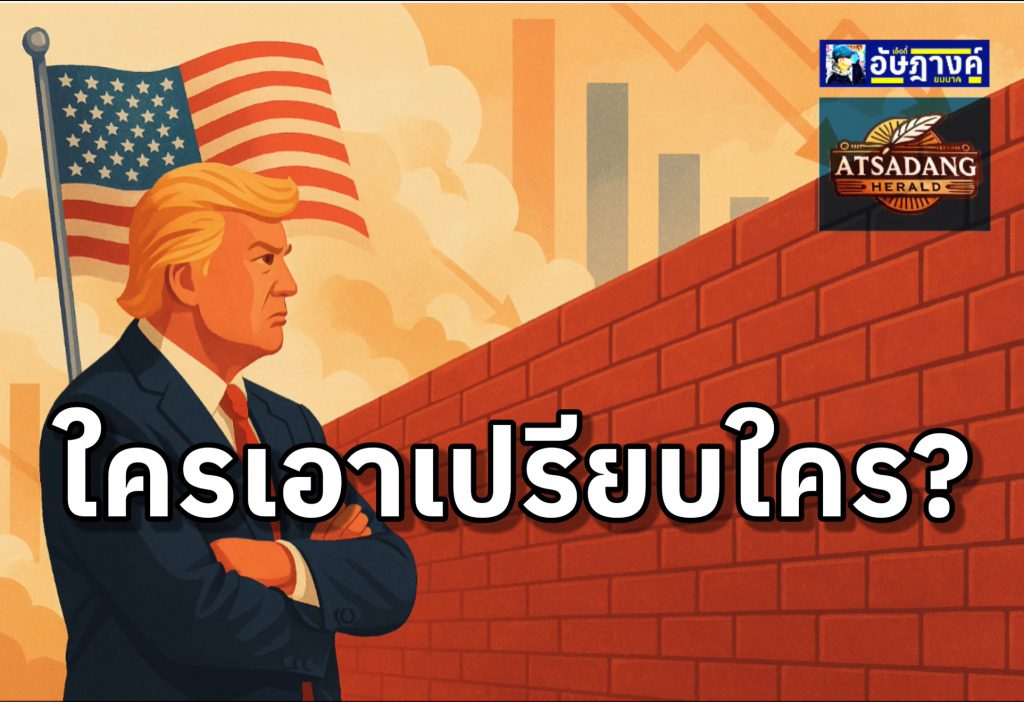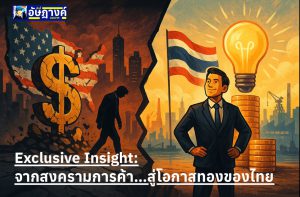
ใครเอาเปรียบใคร?
#อัษฎางค์ยมนาค
ทรัมป์บอกว่า โลกเอาเปรียบอเมริกา เพราะสหรัฐฯ ขาดดุลการค้ากับประเทศต่างๆ โดยเฉพาะจีน
แต่ลองมองอีกด้าน—อเมริกากำลัง เอาเปรียบทั้งโลก ผ่าน “อภิสิทธิ์ของดอลลาร์”
ดอลลาร์เป็นสกุลเงินสำรองของโลก สหรัฐฯ สามารถพิมพ์เงินใช้เองเท่าไหร่ก็ได้โดยไม่ต้องมีทองคำหนุนหลัง
แม้ทรัมป์จะบอกว่าโลกเอาเปรียบอเมริกาเพราะประเทศอื่นเกินดุลการค้ากับสหรัฐฯ แต่ในอีกมุมหนึ่ง โลกก็กำลังถูก เอาเปรียบเชิงโครงสร้าง จาก “อภิสิทธิ์ของดอลลาร์” ซึ่งสหรัฐฯ ได้ประโยชน์มหาศาล:
• สหรัฐฯ พิมพ์เงินเท่าไหร่ก็ได้ แต่ประเทศอื่นต้อง ทำงาน สะสมทุน ส่งออก เพื่อให้ได้ดอลลาร์มาใช้
• สิ่งนี้ทำให้สหรัฐฯ มี “อภิสิทธิ์” หรือที่เรียกในวงวิชาการว่า exorbitant privilege หมายถึงการที่อเมริกาสามารถพิมพ์เงินได้ และยังมีคนเต็มใจถือครอง เพราะต้องการซื้อสินทรัพย์หรือสะสมทุนสำรองในรูปดอลลาร์
• เงินดอลลาร์เป็น “ทุนสำรองโลก” ซึ่งหมายความว่า ทั่วโลกต้องเก็บเงินสหรัฐฯ ไว้ในคลังกลางของตนเอง เพื่อความมั่นคง
• ประเทศเหล่านั้นนำเงินดอลลาร์ไป ซื้อพันธบัตรรัฐบาลสหรัฐฯ ซึ่งเท่ากับ “ให้เงินอเมริกากู้” แถมยัง “มีดอกเบี้ย”
นี่คือการเอาเปรียบเชิงระบบ (Systemic Exploitation) ซึ่งถูกฝังอยู่ในโครงสร้างการเงินโลกตั้งแต่สิ้นสุดสงครามโลกครั้งที่สองผ่านระบบ Bretton Woods
ในขณะที่ ประเทศอื่นไม่มีทางเลือก เพราะ “ไม่มีสกุลเงินอื่น” ที่แทนดอลลาร์ได้
นี่ไม่ใช่การเอาเปรียบหรือ?
ถ้าถามว่า: อเมริกาเอาเปรียบหรือไม่?
คำตอบคือ: “ใช่”
แต่โลกก็สมยอม (co-dependence)
• สหรัฐฯ ได้ประโยชน์จากสถานะเงินสำรองโลก
• โลกก็ได้ประโยชน์จากการเข้าถึงตลาดทุนที่ใหญ่ที่สุด มีสภาพคล่องสูงที่สุด และเชื่อมั่นได้ที่สุด
• แต่ในระยะยาว เมื่อประเทศอื่นเริ่มพัฒนาทางเลือก (เช่น การค้าระหว่างกันด้วยสกุลเงินท้องถิ่น) ดอลลาร์จะถูกท้าทายมากขึ้นเรื่อยๆ
ในขณะที่อเมริกาพิมพ์เงินใช้ได้เองอย่างไม่จำกัดและไม่ต้องมีอะไรค้ำประกัน
แต่อเมริกากลับใช้นโยบายการคลังที่ไม่มีความรับผิดชอบ โดยเฉพาะในช่วง 20 ปีที่ผ่านมา ที่มีการพิมพ์เงินดอลลาร์สหรัฐเพิ่มมากกว่า 4.5 เท่าตัวจากระดับ 4.66 ล้านล้านดอลลาร์สหรัฐใน ค.ศ. 2000 สู่ระดับ 20.85 ล้านล้านดอลลาร์สหรัฐใน ค.ศ. 2023
ความไร้ความรับผิดชอบทางนโยบายการคลังและการเงิน!
ในช่วง 20 ปีที่ผ่านมา สหรัฐฯ ใช้นโยบาย ผ่อนคลายทางการเงิน (QE) และ ดอกเบี้ยต่ำ อย่างต่อเนื่องหลังวิกฤตแฮมเบอร์เกอร์ 2008 และช่วงโควิด ทำให้มีการอัดฉีดเงินเข้าสู่ระบบเศรษฐกิจจำนวนมหาศาล
• เงินเฟ้อทั่วโลก ที่เกิดจาก QE และ supply chain disruption ทำให้ดอลลาร์อ่อนค่า
• สหรัฐฯ ขึ้นดอกเบี้ยอย่างรุนแรง เพื่อต่อสู้กับเงินเฟ้อ (จาก 0.25% สู่ 5.25% ภายใน 10 เดือน)
• ส่งผลให้ ทุนไหลออกจากประเทศกำลังพัฒนา เข้าสู่ตลาดพันธบัตรสหรัฐฯ ที่ให้ผลตอบแทนสูงขึ้น
• และทำให้หลายประเทศรู้สึกว่า “ตกเป็นเหยื่อ” ของนโยบายการเงินสหรัฐฯ
ถ้าถามว่า: นี่คือต้นตอที่เศรษฐกิจอเมริกากำลังจะล่มสลายหรือไม่?
คำตอบคือ: ไม่ถึงขั้น “ล่มสลาย” ในระยะสั้น แต่อเมริกากำลังเผชิญกับปัญหาหนี้สาธารณะระดับ 34 ล้านล้านดอลลาร์ ซึ่งทำให้ความเชื่อมั่นในระบบการคลังของสหรัฐฯ ถูกตั้งคำถาม
• ค่าเงินดอลลาร์ยังแข็ง เพราะยังไม่มี “ตัวแทน” ที่น่าเชื่อถือพอ เช่น ยูโรหรือหยวน
• แต่ “สถานะพิเศษ” ของดอลลาร์กำลังถูกกัดกร่อน จากความไม่ไว้ใจในนโยบายของรัฐบาลสหรัฐฯ
• เมื่อใดที่ “ความเชื่อมั่น” เสื่อมถอย อาจทำให้ดอลลาร์สูญเสียอำนาจแบบที่อังกฤษเคยเจอหลังสงครามโลก
ถ้าถามว่า: การขึ้นภาษีนำเข้า (กำแพงภาษี) ของทรัมป์มีความเกี่ยวข้องหรือไม่?
คำตอบคือ: ใช่
มันมีความเกี่ยวข้องทางอ้อม ทรัมป์เชื่อว่าอเมริกาขาดดุลการค้ากับจีนและประเทศอื่นๆ เพราะถูกเอาเปรียบ และอุตสาหกรรมในประเทศถูกทำลาย
• การขึ้นภาษีนำเข้า คือความพยายาม “ลดการพึ่งพาการผลิตจากต่างชาติ” และกระตุ้นการผลิตในประเทศ
• แนวคิด “Make America Great Again” จึงไม่ใช่แค่การเมือง แต่คือ ยุทธศาสตร์เพื่อฟื้นฟูเศรษฐกิจอเมริกันภายใต้แรงกดดันโลกาภิวัตน์
• ทรัมป์ยัง มองเห็นปัญหาหนี้และการพิมพ์เงิน แต่เขาใช้วิธี “การเมือง” และ “ภาษี” แทนนโยบายการเงิน
สุดท้าย คำถามคือ
ใครกันแน่…ที่เอาเปรียบใคร?
และเมื่ออเมริกาเริ่มถูกโลกทวงคืนความยุติธรรม ทรัมป์กลับบอกว่า “เราต้องเอาคืนเพื่อ Make America Great Again”
แล้วโลกจะยอมอยู่ภายใต้ระบบแบบนี้อีกนานแค่ไหน?
_______________________
Who’s Exploiting Whom?
By: Eddie Atsadāng Yommanāk
Former President Donald Trump has long claimed that the world is taking advantage of the United States, particularly through trade imbalances—most notably with China. But if we shift the lens, one might argue that it is, in fact, the United States that has been exploiting the rest of the world—through what economists call the exorbitant privilege of the US dollar.
As the world’s reserve currency, the US dollar is not backed by gold or any tangible asset, yet it is globally accepted for international trade and financial settlements. The United States can print dollars at will, while other countries must work, trade, and export goods just to earn these dollars.
This privilege allows the US to benefit disproportionately:
• The US can print money as needed, but other countries must produce and trade to earn it.
• It enjoys exorbitant privilege, whereby nations are not only willing to hold US dollars, but also use them to purchase US Treasury bonds—in essence, lending money to the US government, and paying interest on top.
• These dollars are held as part of foreign exchange reserves globally, making them central to national economic security in virtually every country.
• The international financial system, shaped after World War II under the Bretton Woods framework, entrenched the dollar at the center of global trade and finance.
This is a form of systemic exploitation embedded in the architecture of the postwar financial order. And while many countries may not be pleased with it, they’ve had little choice—there is, at present, no viable alternative to replace the dollar on a global scale.
So the question arises:
Isn’t this a form of global economic exploitation by the United States?
The answer is: Yes.
But the world also allows it—a relationship of co-dependence.
• The US benefits from being the issuer of the world’s reserve currency.
• The rest of the world benefits from access to the deepest, most liquid, and most secure financial markets on Earth.
• But this system is being gradually challenged, as countries begin to diversify trade and reserves—for example, by settling bilateral trade in local currencies or reducing dollar holdings.
And yet, while the US prints its own money without restraint or backing, it has also engaged in fiscally irresponsible behavior, especially over the past two decades. From 2000 to 2023, the US money supply ballooned from $4.66 trillion to $20.85 trillion—a 4.5-fold increase.
This reflects a broader pattern of monetary and fiscal recklessness:
• The US relied heavily on quantitative easing (QE) and ultra-low interest rates following the 2008 financial crisis and during the COVID-19 pandemic, flooding the global financial system with liquidity.
• This led to global inflation and a weakening dollar.
• When inflation hit home, the US aggressively hiked interest rates from 0.25% to 5.25% in just 10 months.
• The result? Capital flight from developing economies back to the US bond market, leaving many countries economically destabilized by a system they cannot control.
Is this the root cause of America’s potential economic downfall?
Not entirely—not yet. While the US economy remains powerful, it is grappling with an unsustainable public debt load of $34 trillion. This raises legitimate concerns about the long-term integrity of US fiscal policy.
• The dollar remains strong for now, largely because no alternative currency has yet proven reliable or stable enough to replace it—neither the euro nor the Chinese yuan.
• But the foundations of dollar supremacy are eroding, not due to external enemies, but due to internal mismanagement.
• If global trust in the dollar fades, the US could lose its privileged status—just as the British pound did after WWII.
And how does Trump’s tariff policy fit into all of this?
Quite directly, albeit indirectly. Trump’s “America First” doctrine and tariff wars were aimed at reducing dependency on foreign manufacturing and reviving domestic industry. He believed that America was being exploited by unfair trade practices, particularly by China.
• Tariffs, then, were not just about economics—they were a strategic move to reclaim American control in a globalized economy.
• “Make America Great Again” was not only a political slogan, but also a reaction to America’s diminishing ability to control a system it once created.
• Trump recognized the mounting debt and the unsustainable nature of endless money printing—but addressed it with politics and protectionism, rather than reforming the monetary system.
In the end, we must ask:
Who is truly exploiting whom?
And when the world begins to demand fairness, Trump’s response is:
“We must take back what’s ours—to make America great again.”



